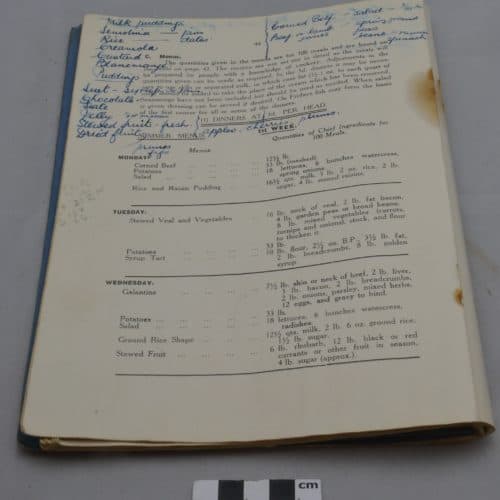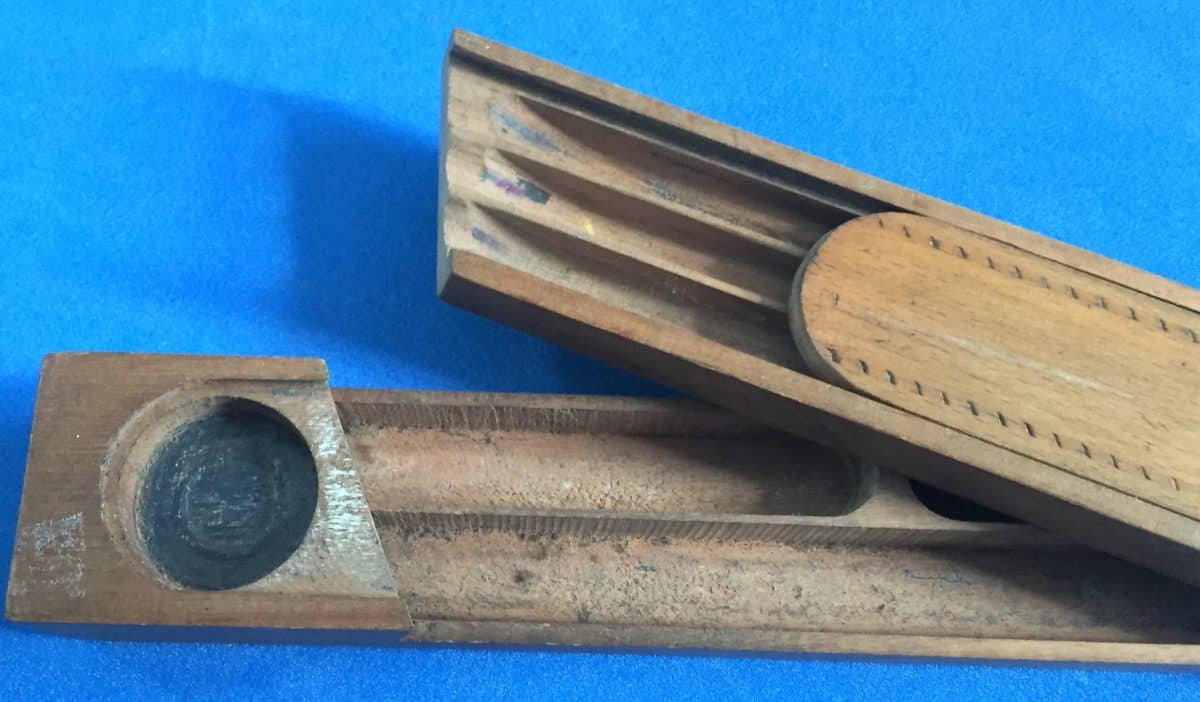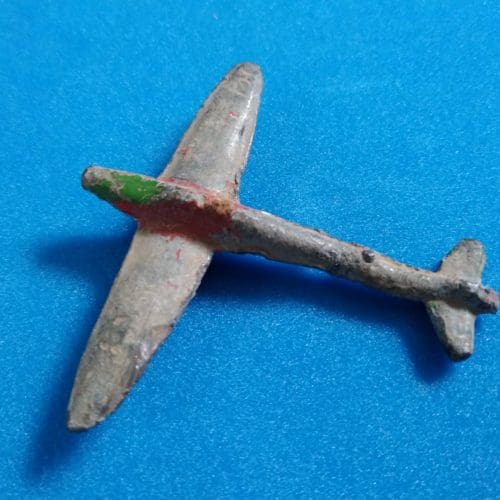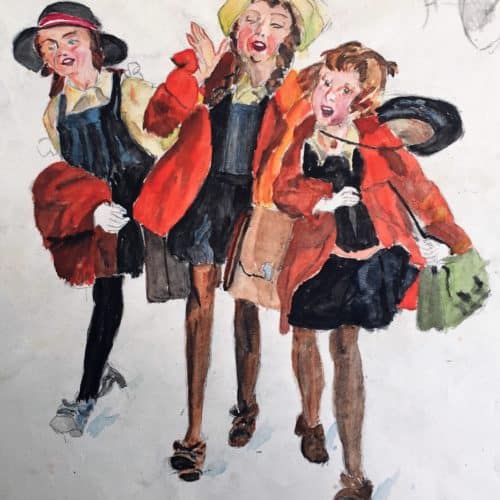WW2 6: Schooldays
This is a medal given as a school prize. It reads ‘For regular attendance.’
It is made of bronze with a blue ribbon and would been pinned to clothing with the safety pin at the top.
It may have been awarded during a school assembly, perhaps at the end of term. Children from poor backgrounds sometimes missed school because their families needed them to work. School prizes like this medal were an incentive for children to attend school.
School was very different in the 1940s. Children sat at rows of wooden desks and the rules were strict. There was even corporal punishment!
Subjects taught were reading, writing, arithmetic, geography and history. Boys were taught practical skills like woodwork and metalwork and girls learnt needlework and cooking.
Fascinating Fact
The school leaving age in 1940 was 14. It was going to be extended to 15 in September 1939 but the outbreak of war meant that it had to be postponed until 1947.
This is a school menu book from the middle of the 20th century. It was used by dinner ladies to plan school meals and order supplies.
You can see that it has been written on by a dinner lady in blue ink, as she planned out the week’s menu.
School meals in the 1940s were very bland. Food was plain: meat and vegetables with a stodgy pudding to follow. There was no pizza, curry or salad! Most children would have had a school dinner, and their parents had to pay for them.
Can you see what the children were having to eat on Tuesday and Wednesday?
With the outbreak of war school dinners were subject to rationing and school dinners became even more boring.
Tapioca pudding became school dinner staple. Tapioca pudding’s nickname was frogspawn because that is what it looked like!
Fascinating Fact
In the 1940s each schoolchild was given a third of a bottle of milk in small glass bottles. The milk was provided to help with children’s nutrition so that they could learn better. Free school milk was introduced in 1906 and ended in 1971.
This is a school exam paper, from 25th May 1940. The exam is for both arithmetic and English. You can see that all the maths questions are written in the pre-decimal currency of pounds, shillings and pence.
Take a look at question (4). Do you know the opposite meaning to any of the words?
The date on the exam is important. This was a desperate time. Just across the Channel from the children taking this exam, Boulogne was being captured by the Germans. The next day, the British Army began to be evacuated from Dunkirk.
Nearly every large and small boat from Folkestone Harbour went to help bring back the troops and wounded, and thousands of battle-weary and injured soldiers soon began to arrive in the town. By 2nd June 1940 most school children from Folkestone were evacuated out of the time.
Bedingfield’s Educational Endowment was a fund that provided support for academic children from poor backgrounds in Kent, specifically the parishes of Dymchurch, Smeeth & Lyminge.
Children in the 1940s didn’t take GCSEs like today. Instead, they took a general exam called the School Certificate. Performance in the exam was judged either as a fail, pass, credit or distinction. Children had to obtain 6 passes, including English and arithmetic, to receive the certificate.
Question 5 on the exam paper refers to the Dig for Victory campaign.
To find out more have a look at WW2 4: Dig for Victory.
Fascinating Fact
The School Certificate was established in 1918 and abolished in 1951 when it was replaced by ‘O’ Levels, the school exams before GCSEs.
This is a wooden pencil case dating to the 1940s.
It would have contained everything a child needed for school. It has different sections for pencils and pens, and even an inkwell!
Compare your pencil case to the one in the photograph. What differences and similarities are there?
Schooling was very disrupted during the war and there were shortages of pencils, textbooks and paper. Many children would have had to share educational material.
In the summer months, some classes like needlework were held outdoors, both for safety from bombs and for fresh air.
Children’s toys were also rationed, as materials needed to make them and toy manufacturing was turned over to war work. Instead, children made up games, played on bombsites and had a few toys that were made for them which they received on birthdays and Christmas.
This is a toy plane made from metal. You can still see areas with the original paint. Planes were a popular toy for boys in the 1940s, as it was wartime. Girls generally had toys like dolls and skipping ropes.
Fascinating Fact
Toy and sweet rationing existed long after the end of the war in 1945. It took time for toy manufacturers to go back to making toys and materials remained scarce. Sweet rationing went on until 5th February 1953, over 13 years after the end of the war!
This is a watercolour sketch of three 1940s schoolgirls going to school in their uniforms.
School uniform of the period was itchy and heavy, often made of a thick tweed or wool material. Girls often wore pinafore dresses over a shirt, flat shoes and ankle socks or stockings. Boys would have worn shorts until the age of 12 or 13, with a shirt, jacket and tie. Almost all children would have gone to school wearing a cap, beret or other type of hat as part of their uniform, as hats were worn by most people in the 1940s.
Outside of school, children’s clothes were rationed in the 1940s and many children wore ‘hand-me downs’, clothing that no longer fitted older brothers and sisters.
In terms of style, children's casual clothes were like school uniforms: shorts, shirt & jacket for boys and dresses or skirts for girls. Very few schoolgirls would have worn trousers during the war years!
Fascinating fact
From 1942 all children were given an extra 10 clothing ration coupons to account for the fact that they needed new clothes as they grew. Coupons were also needed for school uniforms as many schools didn’t relax rules on uniform even in war time.






